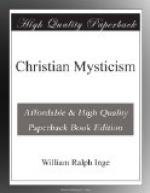[Footnote 258: “Vir ut ferunt devotus sed parum litteratus,” says the Abbe Tritheme (ap. Gessner, Biblioth.). “Rusbrochius cum idiota esset” (Dyon. Carth. Serm. i.). Compare Rousselot, Les Mystiques Espagnols, p. 493.]
[Footnote 259: Maeterlinck, Ruysbroek’s latest interpreter, is far too complimentary to the intellectual endowments of his fellow-countryman. “Ce moine possedait un des plus sages, des plus exacts, et des plus subtils organes philosophiques qui aient jamais existe.” He thinks it marvellous that “il sait, a son insu, le platonisme de la Grece, le soufisme de la Perse, le brahmanisme de I’Inde et le bouddhisme de Thibet,” etc. In reality, Ruysbroek gets all his philosophy from Eckhart, and his manner of expounding it shows no abnormal acuteness. But Maeterlinck’s essay in Le Tresor des Humbles contains some good things—e.g. “Les verites mystiques ne peuvent ni vieillir ni mourir.... Une oeuvre ne vieillit qu’en proportion de son antimysticisme.”]
[Footnote 260: So Preger, probably rightly. Noack places his birth five years later. The chronology of the Life is very loose.]
[Footnote 261: The extreme asceticism which was practised by Suso, and (though to a less degree) by Tauler, is not enjoined by them as a necessary part of a holy life. “We are to kill our passions, not our flesh and blood,” as Tauler says.]
[Footnote 262: It would be very interesting to trace the influence of the chivalric idea on religious Mysticism. Chivalry, the worship of idealised womanhood, is itself a mystical cult, and its relation to religious Mysticism appears throughout the “Divine Comedy” and “Vita Nuova” (see especially the incomparable paragraph which concludes this latter), and in the sonnet of M. Angelo translated by Wordsworth, “No mortal object did these eyes behold,” etc.]
[Footnote 263: Nothing in the book is more touching than the scene when the baby, deserted by its mother, Suso’s false accuser, is brought to him. Suso takes the child in his arms, and weeps over it with affectionate words, while the infant smiles up at him. In spite of the calumny which he knew was being spread wherever it would most injure him, he insists on paying for the child’s maintenance, rather than leave it to die from neglect. The Italian mystic Scupoli, the author of a beautiful devotional work called the Spiritual Combat, was calumniated in a similar manner.]
[Footnote 264: By Schmidt, whose researches formed the basis of several popular accounts of Tauler’s life. Preger and Denifle both reject the identification of the mysterious stranger with Nicholas; Denifle doubts his existence altogether. The subject is very fully discussed by Preger]
[Footnote 265: Tauler was well read in the earlier mystics. He cites Proclus, Augustine (frequently), Dionysius, Bernard, and the Victorines; also Aristotle and Aquinas.]




